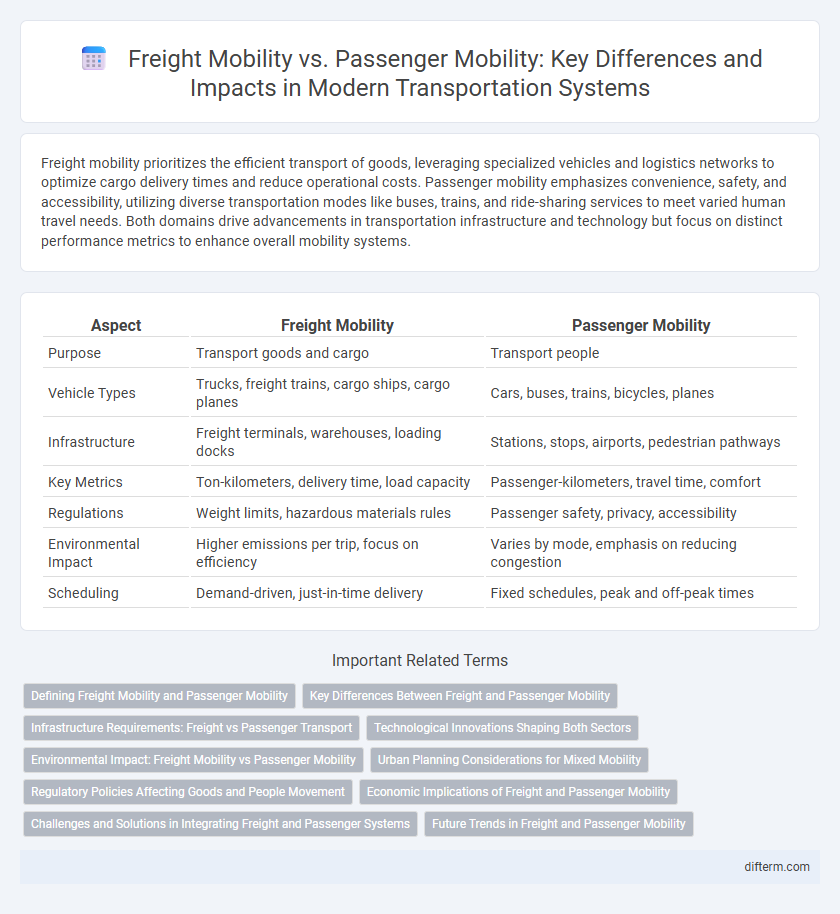Freight mobility prioritizes the efficient transport of goods, leveraging specialized vehicles and logistics networks to optimize cargo delivery times and reduce operational costs. Passenger mobility emphasizes convenience, safety, and accessibility, utilizing diverse transportation modes like buses, trains, and ride-sharing services to meet varied human travel needs. Both domains drive advancements in transportation infrastructure and technology but focus on distinct performance metrics to enhance overall mobility systems.
Table of Comparison
| Aspect | Freight Mobility | Passenger Mobility |
|---|---|---|
| Purpose | Transport goods and cargo | Transport people |
| Vehicle Types | Trucks, freight trains, cargo ships, cargo planes | Cars, buses, trains, bicycles, planes |
| Infrastructure | Freight terminals, warehouses, loading docks | Stations, stops, airports, pedestrian pathways |
| Key Metrics | Ton-kilometers, delivery time, load capacity | Passenger-kilometers, travel time, comfort |
| Regulations | Weight limits, hazardous materials rules | Passenger safety, privacy, accessibility |
| Environmental Impact | Higher emissions per trip, focus on efficiency | Varies by mode, emphasis on reducing congestion |
| Scheduling | Demand-driven, just-in-time delivery | Fixed schedules, peak and off-peak times |
Defining Freight Mobility and Passenger Mobility
Freight mobility involves the efficient movement of goods and cargo through various transportation modes such as trucks, trains, ships, and airplanes, prioritizing capacity, reliability, and delivery speed. Passenger mobility focuses on the transportation of people using public transit, private vehicles, walking, and cycling, emphasizing accessibility, safety, and convenience. Both freight and passenger mobility contribute to comprehensive transportation systems but require distinct infrastructure and operational strategies to optimize performance.
Key Differences Between Freight and Passenger Mobility
Freight mobility prioritizes the efficient transport of goods, emphasizing load capacity, route optimization, and cost-effectiveness, while passenger mobility focuses on comfort, safety, and travel time for individuals. Infrastructure for freight mobility often involves specialized vehicles like trucks, cargo trains, and shipping containers, designed for heavy loads and long distances, contrasting with passenger mobility's use of cars, buses, and trains optimized for speed and convenience. Regulatory requirements differ significantly, with freight mobility subject to weight limits, hazardous material handling, and delivery schedules, whereas passenger mobility adheres more to safety standards, accessibility, and traffic management.
Infrastructure Requirements: Freight vs Passenger Transport
Freight mobility demands robust infrastructure such as heavy-duty roads, railways, and specialized loading terminals designed to support high weight and volume, whereas passenger mobility prioritizes extensive transit networks, including metro systems, bus lanes, and pedestrian pathways for efficient human movement. Freight corridors require durable pavement and larger turning radii to accommodate trucks and freight trains, contrasting with passenger transport infrastructure that emphasizes accessibility, frequency, and safety features like well-lit stations and real-time information systems. Investing in bespoke infrastructure for each mode optimizes operational efficiency, reduces congestion, and enhances overall transportation system sustainability.
Technological Innovations Shaping Both Sectors
Technological innovations such as autonomous vehicles, advanced telematics, and blockchain-based logistics platforms are revolutionizing freight mobility by enhancing route optimization, cargo tracking, and supply chain transparency. In passenger mobility, the integration of electric vehicles, ride-sharing apps, and real-time data analytics improves efficiency, reduces emissions, and elevates user convenience. Both sectors benefit from the convergence of IoT devices and AI-driven predictive maintenance, driving smarter, more sustainable transportation ecosystems.
Environmental Impact: Freight Mobility vs Passenger Mobility
Freight mobility typically generates higher greenhouse gas emissions per ton-kilometer compared to passenger mobility due to the heavier loads and reliance on diesel-powered trucks and cargo ships. Passenger mobility, while contributing significantly to urban air pollution and CO2 emissions, benefits more from electrification and public transit options that reduce per capita environmental impact. Innovations in freight logistics, such as route optimization and the adoption of electric or hydrogen-powered vehicles, are critical to minimizing the environmental footprint of goods transportation.
Urban Planning Considerations for Mixed Mobility
Urban planning for mixed mobility prioritizes seamless integration of freight and passenger transport to optimize city logistics and reduce congestion. Designing dedicated freight corridors and timed loading zones enhances efficiency while minimizing disruptions to passenger flow. Incorporating smart traffic management systems and sustainable mobility solutions fosters balanced urban environments supporting diverse transport demands.
Regulatory Policies Affecting Goods and People Movement
Regulatory policies for freight mobility prioritize safety standards, weight restrictions, and emissions controls to ensure efficient and secure transport of goods across regions. Passenger mobility regulations emphasize accessibility, traffic flow, and public transit standards to enhance user convenience and reduce congestion. Both sectors face evolving policies aimed at integrating sustainable practices and technology-driven solutions to support seamless movement.
Economic Implications of Freight and Passenger Mobility
Freight mobility drives economic growth by enabling efficient supply chains, reducing delivery times, and lowering transportation costs, which enhances competitiveness in global markets. Passenger mobility supports labor market flexibility, boosts tourism revenue, and stimulates local economies through increased consumer spending in urban and suburban areas. Investments in infrastructure for both freight and passenger transport yield significant returns by improving accessibility, reducing congestion, and fostering economic productivity.
Challenges and Solutions in Integrating Freight and Passenger Systems
Integrating freight and passenger mobility systems faces challenges such as conflicting infrastructure demands, scheduling conflicts, and varying safety regulations. Solutions include developing dedicated freight corridors within urban transit networks, implementing advanced traffic management systems using real-time data, and adopting multimodal hubs that prioritize seamless transfers between freight and passenger transport. Harmonizing policy frameworks and leveraging smart technology enhance operational efficiency and reduce congestion in shared transport environments.
Future Trends in Freight and Passenger Mobility
Future trends in freight mobility emphasize autonomous delivery vehicles, drone logistics, and smart supply chain integration to enhance efficiency and reduce environmental impact. Passenger mobility is shifting toward electric vehicles, Mobility-as-a-Service (MaaS) platforms, and seamless multimodal transportation systems to improve accessibility and reduce congestion. Both sectors increasingly rely on data analytics, IoT, and AI technologies to optimize routes, predict demand, and support sustainable urban mobility solutions.
freight mobility vs passenger mobility Infographic

 difterm.com
difterm.com